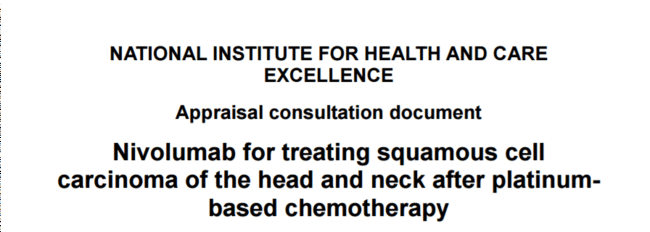Nivolumab for head and neck cancer: why did NICE say no?
NICE has published draft guidance that an immunotherapy treatment, nivolumab, is not cost-effective for metastatic head and neck cancer. The guidance is still in consultation and therefore may change. But in the meantime the initial evidence has been published, so we can see what NICE’s reasoning was.
In this blog I’m going to take a look at what NICE has said and compare it with this news piece from the Institute of Cancer Research (ICR). I want to see what gets lost in translation.
The first thing I did when opening the appraisal consultation was to scroll straight down to the cost-effectiveness result. This section presents a variety of results, with the assumptions of each (poorly) explained. The results are presented as incremental cost-effectiveness ratios (ICERs). An ICER is simply the amount of money it would cost to get one unit of benefit from the new treatment. In this case, if we switch to using nivolumab, we expect that patients will live slightly longer with slightly better quality of life. These two measures can be combined into a quality-adjusted life year (QALY). So the ICER measures the cost of one extra QALY.
NICE’s cost-effectiveness threshold, the amount it is willing to pay for that extra QALY, is £20,000-£30,000. It is immediately clear that the ICERs for nivolumab are much higher. The lowest is £38,000, the highest nearly £70,000. The reason this value varies is that it is the result of calculation that includes assumptions about, for example, how effective nivolumab is, how long patients with this type of cancer live normally, and what the costs of their other treatments are. When the Pharma company submitted their drug for evaluation, they included their own calculation based on their own assumptions. Different parties, including the decision making committee at NICE and an economic review group that act as expert reviewers, have changed some of these assumptions, which in turn changes the ICER value.
So it is pretty clear that this isn’t a cost-effective treatment for the NHS. The NHS would have to spend more money trying to implement this than it would be worth. This is because that money is currently spent somewhere else in the NHS, where it does more good for patients than nivolumab would.
Comparing NICE’s guidance to the ICR’s news coverage, one point that jumps out is the mention of comparators. These are alternative treatments for the patients who would be eligible for nivolumab if it became available. The ICR coverage makes it sound like this is a treatment with no alternatives, and therefore the loss for patients is particularly acute. NICE, on the other hand, includes 3 alternative treatments in their assessment.
We don’t know anything about how good these comparators are at treating head and neck cancer, but the very fact that the ICER for nivolumab is so high (ie, expensive) suggests that the health benefits compared to the current treatment must be small. While NICE acknowledges that this is a disease without many treatment options, if this was a real breakthrough treatment you would expect a smaller ICER, which would mean a big health benefit for the extra money. The fact the ICER is high suggests that the benefits aren’t all that impressive.
Finally, NICE references the idea that some patients might benefit more than others. Specifically, patients whose tumours express high levels of PDL1. There is evidence that the treatment may be more effective in these patients, and NICE makes a point of asking for more evidence so that it can look at the cost-effectiveness of nivolumab just in these patients. It is the manufacturer (Bristol-Myers-Squibb) who consider that this analysis would be “inappropriate”, although they don’t say on what grounds. In fact they do provide evidence from their clinical trials on these patients, which shows that the treatment only seems to have an effect in these high-expressing patients. The survival in low expressing patients is 5.7 months in those given the comparator treatment, and 5.8 in the nivolumab-treated group.
The cynic in me wants to know how many fewer units of the drug BMS would sell if only high-PD-L1 expressing patients were eligible for treatment.
So, in summary, this is a treatment that may, in fact, be effective in a select subgroup of patients. But in all patients, compared with all the treatments the NHS already uses, approving this drug at this price would leave the NHS worse off, both financially and as a provider of good health. If this drug was approved in all patients, the initial evidence suggests that it might actually do no good at all for those who don’t have high PD-L1 expression.
And almost none of that made it into the ICR’s coverage.
